Terraforming Mars is a strategy board game that incorporates resource management, drafting, and tile placement. It’s set in the 2400s with the players taking the role of tenacious corporations who are each looking to spend entire generations of settlers to be the first to make Mars habitable. Each corporation competes for getting the most victory points, which can be earned not only by contributing to the Mars terraforming process but also for doing commendable things in the game.
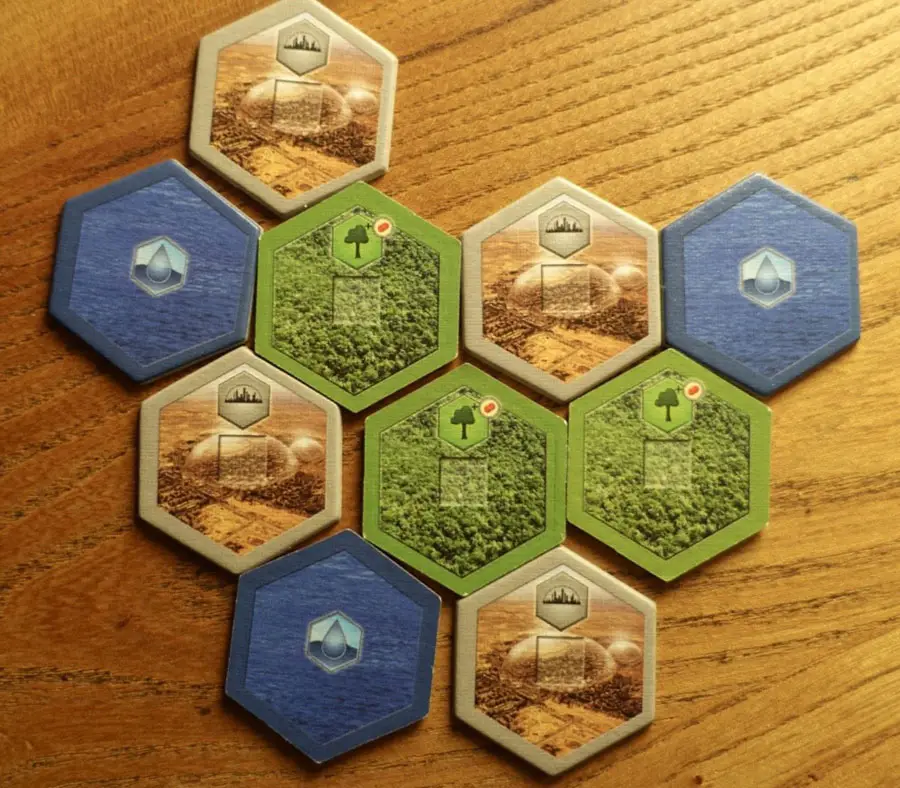
This How-to-Play guide will help you navigate through the complex and sometimes confusing structure of the Terraforming Mars mechanics.
Game Components
The Terraforming Mars box contains more than 230 playing cards, 5 player boards, an accurate map of the planet Mars, over 400 multi-colored markers (200 transparent markers, 200 resource markers, plus 3 game board markers), and 80 tiles to place on the board to mark oceans, greeneries, cities, and special tiles.

It also includes a detailed rule book that indicates the uses and functions of each game piece.
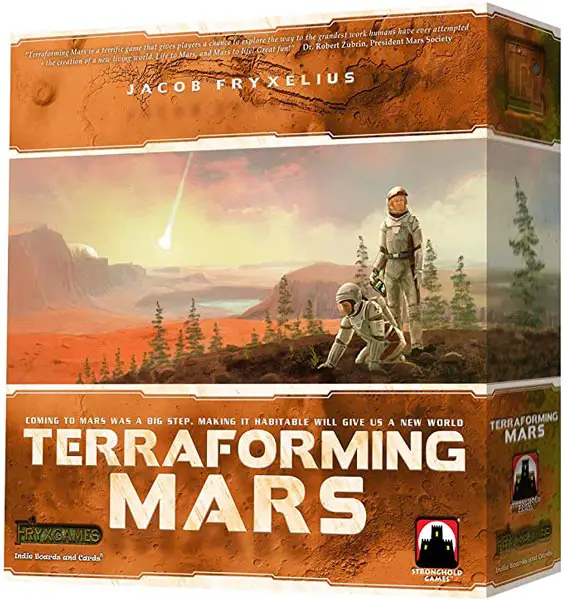
- Compete for different milestones and awards worth many VPS
- Mais de 200 projectos diferentes para completar
The Setup and The Basics of Terraforming Mars Rules
Passo 1
To start the game, place the game board in the middle of the table and set all 9 ocean tiles on the hexagonal space on the top-right part of the board.
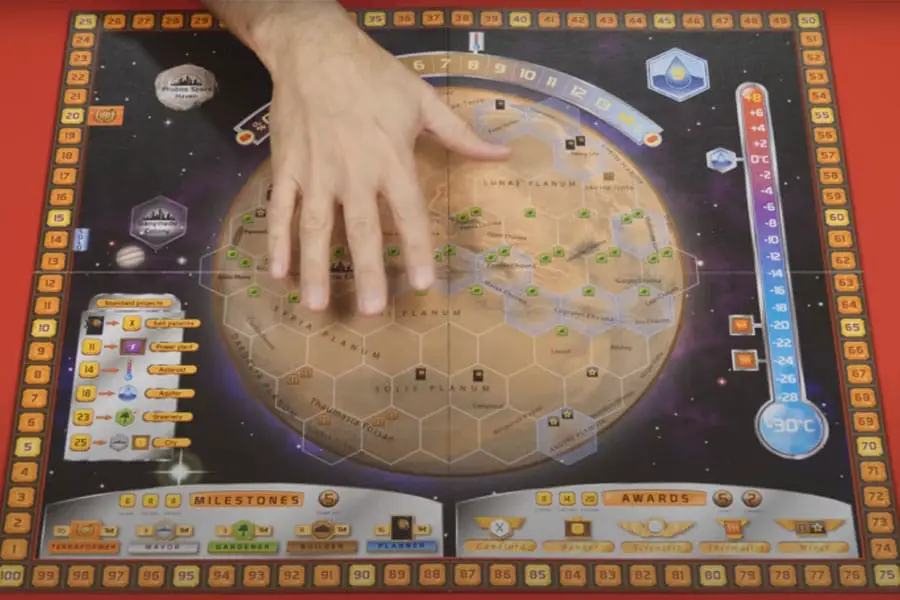
Passo 2
On the edge of the board is a track that represents your Terraform Rating (TR) levels; place 1 white marker on the “1” space.
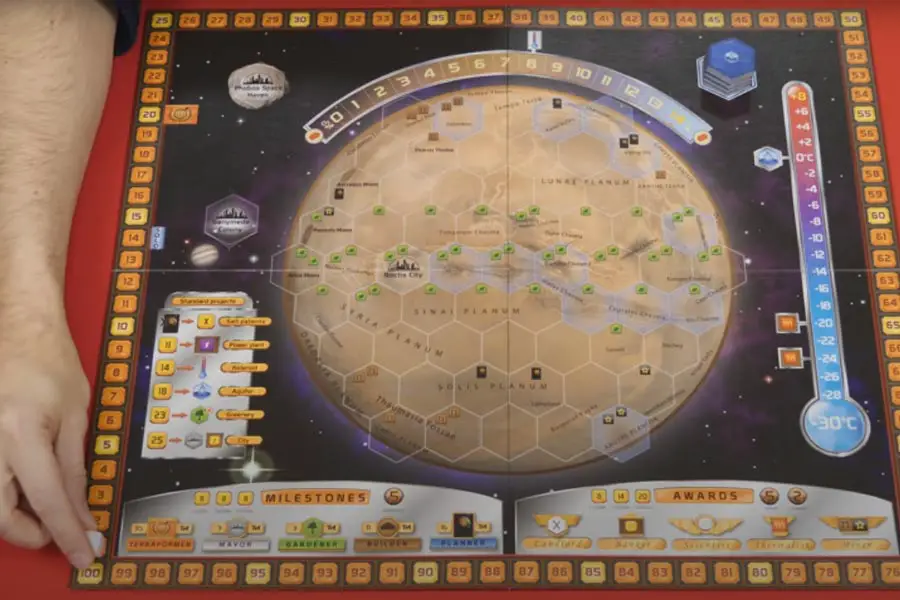
Etapa 3
The oxygen levels are measured using the oxygen scale which is the arched figure on top of the board; place 1 white marker on the “0%” space.

Passo 4
Finally, the temperature is measured using the thermometer located on the right-hand corner of the board; place 1 white marker on the “30°C” space.

Step 5
Now, have each player collect one game board and cubes in one of the 5 player colors. On your player board, you’ll find the symbols for the six types of resources available in the game: Megacredits, Steel, Titanium, Plants, Energy, and Heat.
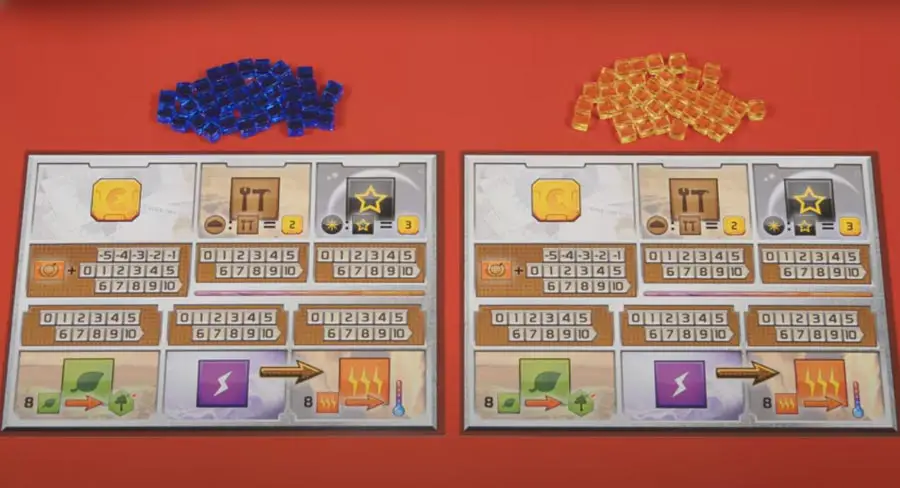
Step 6
On your player board, you’ll also find a track that helps you monitor your corporation’s production. Place 1 colored marker on the “1” space of each track.

Put another colored marker on the “20” space of the TR track.
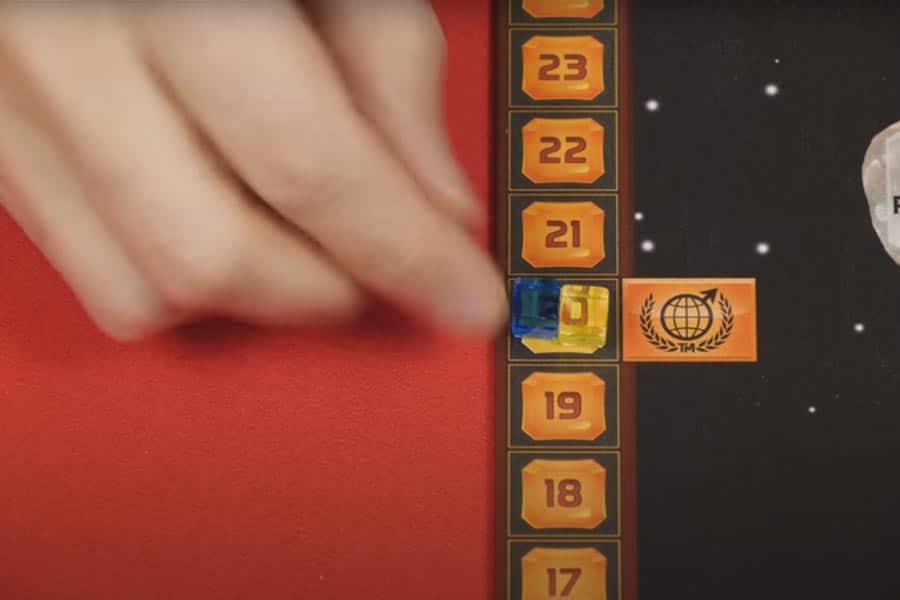
Step 7
In this step, each player is dealt two random corporation cards to choose from. These cards indicate their base resources at the beginning of the game. Any time you gain a certain amount of any resource from cards or achievements, you take a corresponding number of cubes from the supply and place them on your player board.
- Bronze Cubes – worth 1 each
- Silver Cubes – worth 5 each
- Gold Cubes – worth 10 each
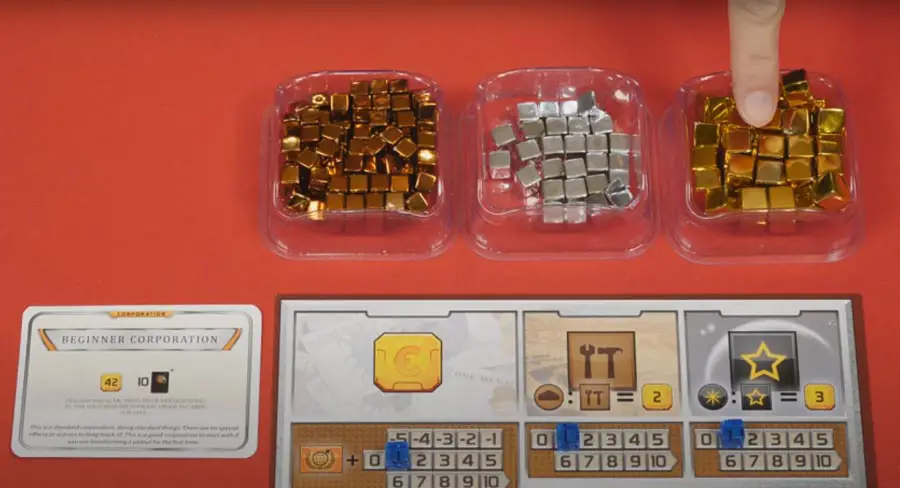
Step 8
On top of these corporation cards, players also acquire 10 unique project cards which each represent different functions such as introducing plant life or animal life, hurling asteroids at Mars’ surface to increase the temperature, as well as building cities. These cards can also reward the player with immediate bonuses that help increase their chances of winning the game.
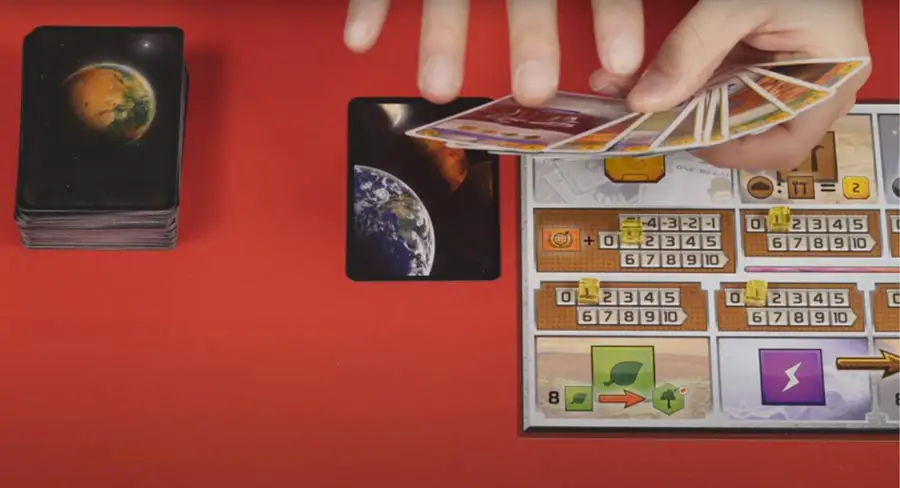
Players have the choice of buying all 10 cards or only keep a select few in their hands. Each card costs 3 Megacredits, so if you want to keep all 10, you’ll need to pay 30 for the Supply.
Step 9
Any cards that aren’t chosen are placed facedown on the table to start a discard pile.
It’s important to note that buying cards can become quite pricy at some point in the game. When this happens, you can always utilize Standard Projects to take yourself further in the game.
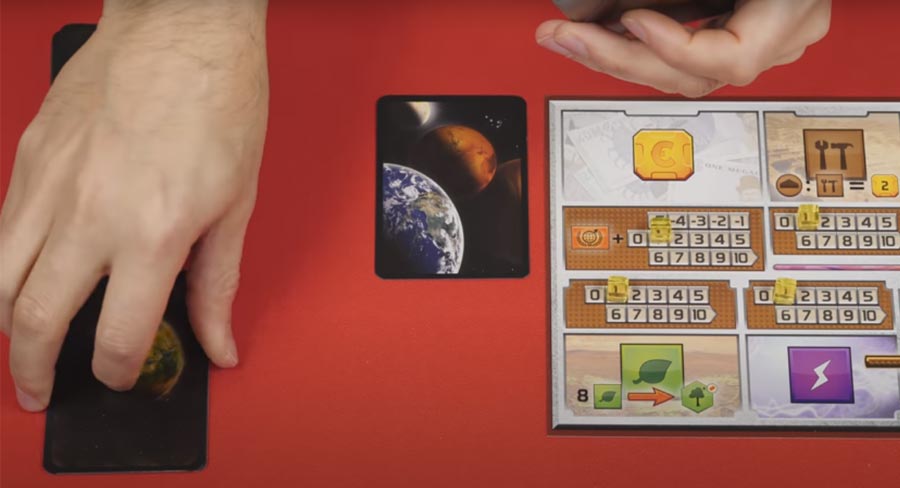
The Three Global Parameters
Each player in Terraforming Mars engages in a variety of events that help improve 3 Global Parameters: Temperature, Ocean levels, and Oxygen levels.
Raising temperature levels by one step doesn’t gain you any points. You just move the white marker up one space. However, when you reach certain points on the scale, you earn corresponding rewards for your corporation. For instance, when you reach -24°C and -20°C it lets you raise your heat production, and at 0°C it lets you place an ocean tile.
Ocean tiles can only be placed on designated ocean spaces — these are indicated by the hexagons with the blue outlines on the game board. You get 2 main credits for each adjacent tile you place.
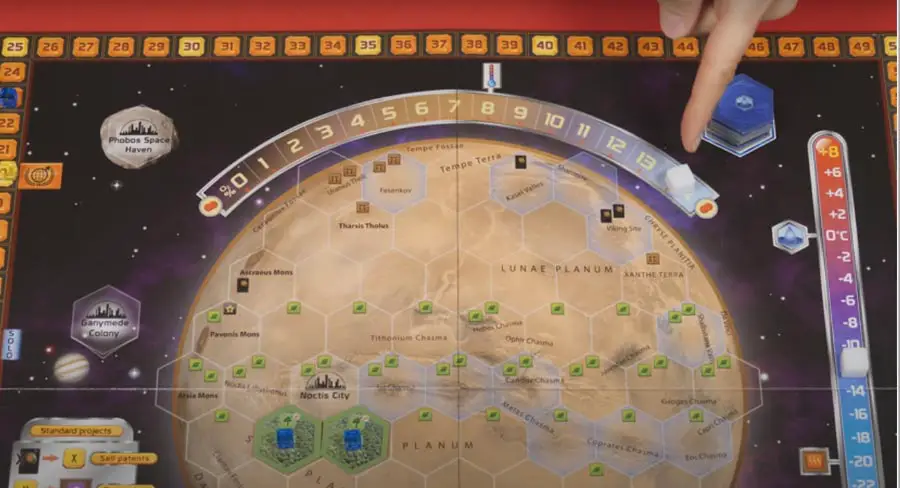
Lastly, we have oxygen.
Some cards can help increase the oxygen levels directly, but most of the time you’ll raise this parameter by placing greenery tiles on the board. When placing one of these greenery tiles, if possible, it must be next to a tile that you own.
If you don’t yet own any of the tiles on the board or don’t have enough space next to the ones that you own, you can place your greenery tile on any free space, except for those meant for ocean tiles and special locations which are reserved for cities.
After placing a greenery tile, raise the oxygen level one step, which at some point, will also raise the temperature later on.
Whenever you advance in any of these parameters, you’ll also be able to advance your TR by one, which then equal points and help you earn more money in late game.
Once all three of these parameters are set in place, this triggers the end game, and players are given a final opportunity to make Mars a little greener before final points are tallied.
Gameplay and Generations
Terraformação de Marte takes place over the course of several “generations” represented by game rounds. Each round is broken into four phases: player order phase, research phase, action phase, and production phase. (You’ll find these phases in the included Player’s Guide.)
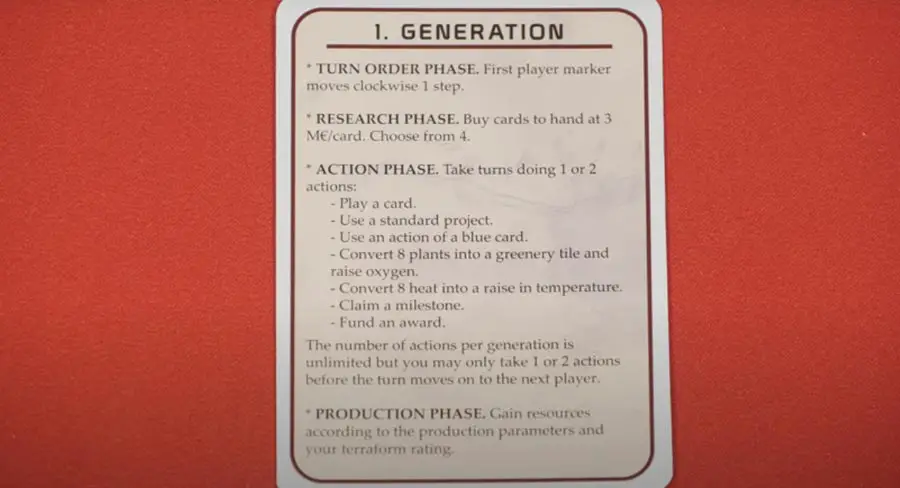
Action Phase
During the action phase, each player gets a chance to play one or two actions, starting from the player with the first player token. If you play two actions during a turn, both actions can be the same or different. Once the first player is done performing an action, the game continues in clockwise order until everyone has played their turn. If you can’t or don’t want to perform an action, you can skip the turn and pass it to the next player.
There are 7 possible actions you can choose from and you will find these on your Reference Card. These are:
- Play a card.
- Use a standard project.
- Use an action from a blue card.
- Convert 8 plants into greenery tile and raise oxygen.
- Convert 8 heat to raise the temperature.
- Claim a milestone.
- Fund a reward.
Playing a Card
The first type of action you can take is playing a card from your hand. Every card in the game is totally unique and each has a variety of symbols on them that represent different actions, bonuses, or consequences for your corporation.
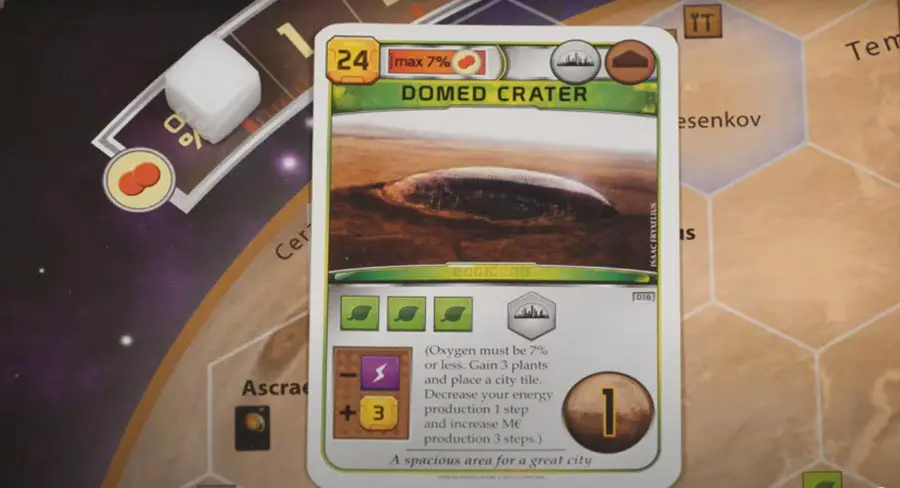
If you aren’t sure what these symbols represent, you can always read the details listed on the card or refer to the back of your Rule’s Book to see a detailed description.
Project cards represent actions that your corporation can carry out and there are 3 types: Event (red), Automated Projects (green), and Active Projects (blue).
Playing a card is simple — there’s a cost of mega credit found on the top left side of the card, and a few other prerequisites beyond that, such as a minimum or maximum amount of some other global parameter or resource.
Sometimes, a production cost is highlighted by a red border, which means you can ask any player to pay for the costs in your stead. Alternatively, if the resource has a brown borer, it increases your production by the number indicated on the card.
Cards can only be activated once per round, so when in play, place a colored marker on the card.
Using a Standard Project
There are 6 different types of standard projects which are all listed on the side of the board. These are:
- Sell Patents: This allows you to discard any card from your hand, gaining one Megacredit for each.
- Power Plant: This increases your energy production by “1” step when you pay 11 Megacredits.
- Asteroid: This allows you to increase the temperature level by “1” step after paying 14 Megacredits.
- Aquifer: This lets you place an ocean tile anywhere on the board after paying 18 Megacredits.
- Greenery: This allows you to place a greenery tile on the board after paying 23 Megacredits.
- City: This allows you to increase your Megacredit production by “1” step and lets you place a city tile on the board after paying 25 Megacredits.
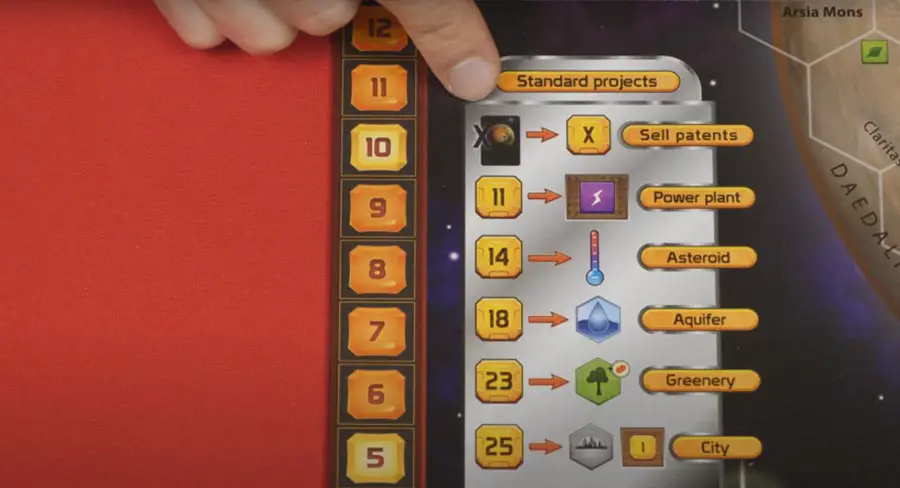
Blue Actions
Another step you can take on your turn is playing blue cards actions.
Playing Blue Action Cards is essentially the same as playing normal cards — you must pay its costs, meet its requirements, and be able to carry out any immediate effects listed on the bottom corner of the card. Blue Actions can only be used once per generation.

Some Blue Actions won’t have a cost, however, it may indicate the need for other factors such as animals, forests, etc. If such is the case, place one supply cube on the card to make up for the requirement. These will later add up to victory points to win the game.
Trade in Plants to Raise Greenery
The fourth action you can take is trading in 8 plants for a Greenery Tile. Greenery tiles increase the Oxygen level, which in turn raises your TR by “1.”
As mentioned before, Greenery tiles are best placed beside a tile that you already own, however, if you don’t have that yet, you may place it on any other vacant spaces on the board and earn corresponding bonuses and points after.

Trade in Heat to Raise Temperature
Similar to the previous action, you can also trade in 8 heat to raise the temperature by “1” step and gain “1” TR, to raise your odds of winning.

Claim a Milestone
Claiming a milestone is another type of action you can play, and you can find the types of milestones at the bottom left corner of the board.
Milestones are like achievements. When you accomplish one of them, you can claim the milestone as an action by paying 8 Megacredits and placing cubes on the milestone you’ve achieved plus the cost. At the end of the game, you’ll gain 5 points for each milestone you’ve claimed.
There are 5 types of milestones:
- Terraformer: Requires you to have at least 35 TR.
- Mayor: Requires you to have at least 3 cities.
- Gardener: Requires you to have at least 3 greeneries.
- Construtor: Requer que tenha pelo menos 3 símbolos de construção no seu quadro.
- Planeador: Requer que tenha pelo menos 16 cartas na sua mão ao mesmo tempo.
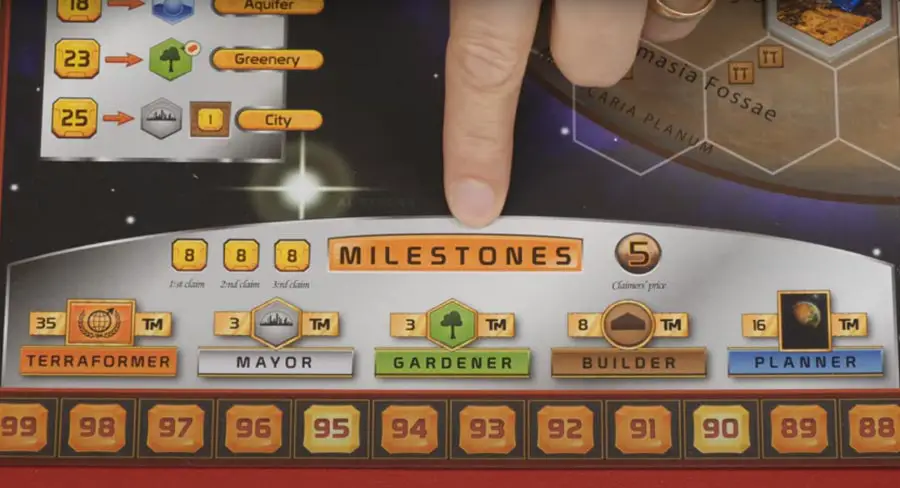
Fund an Award
Quando realiza uma ação para reclamar um prémio, paga o custo correspondente, que aumenta depois de cada jogador realizar uma ação para reclamar um prémio. Há 5 prémios em disputa e, no final do jogo, os vencedores recebem 5 pontos e os segundos classificados recebem 2 pontos.
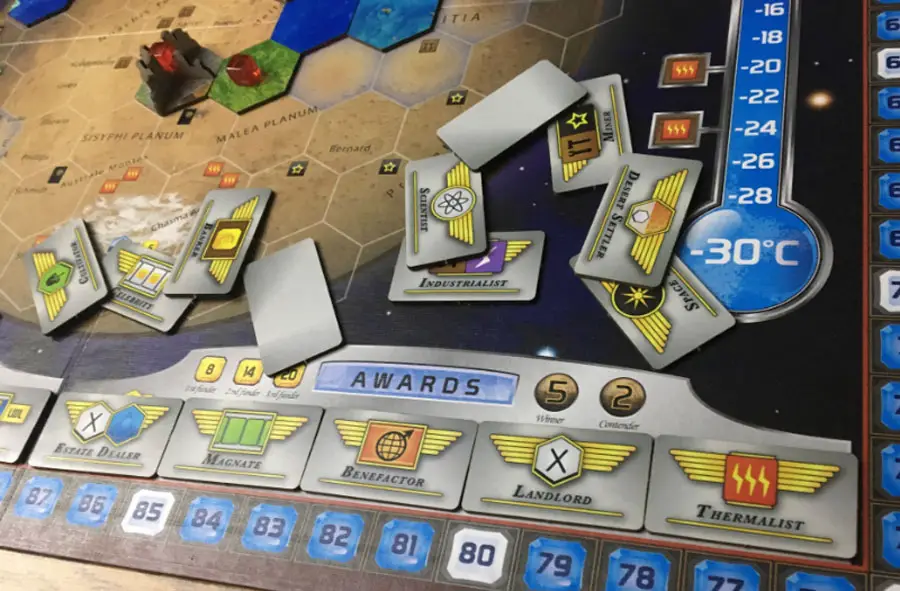
Se dois jogadores empatarem no segundo lugar, ambos recebem 2 pontos. Se dois jogadores empatarem no primeiro lugar, ambos recebem 5 pontos, sem que nenhum outro jogador fique em segundo lugar.
As 5 categorias de prémios são:
- Proprietário: A maioria das peças do tabuleiro.
- Banqueiro: Maior valor de produção do Megacrédito.
- Cientista: A maioria das etiquetas de ciência em jogo, exceto Cartas de Evento.
- Termalista: Maior número de cubos de Calor no final do jogo.
- Mineiro: A maioria dos cubos de aço e titânio no final do jogo.
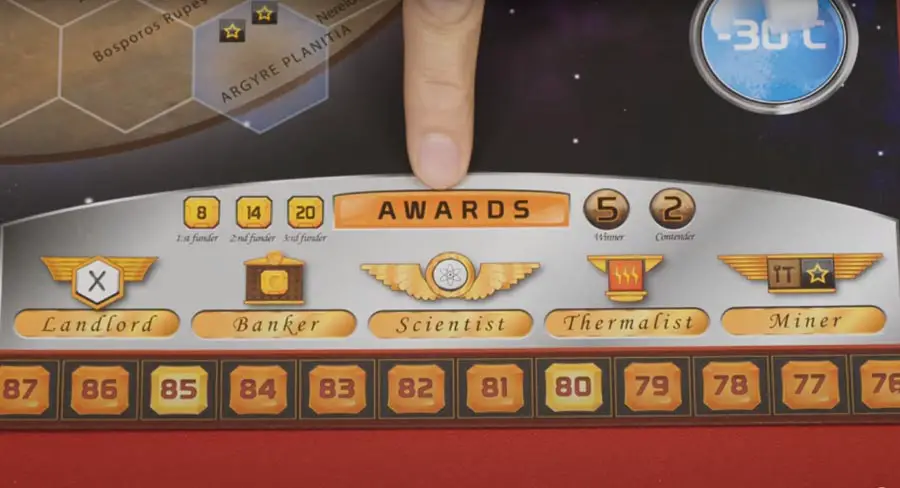
Corporation Abilities
Já passámos em revista todas as acções, mas é importante não esquecer que as corporações únicas também podem fornecer acções e capacidades que podem ser utilizadas na sua vez. Por isso, esteja atento a elas e utilize-as quando for mais apropriado.
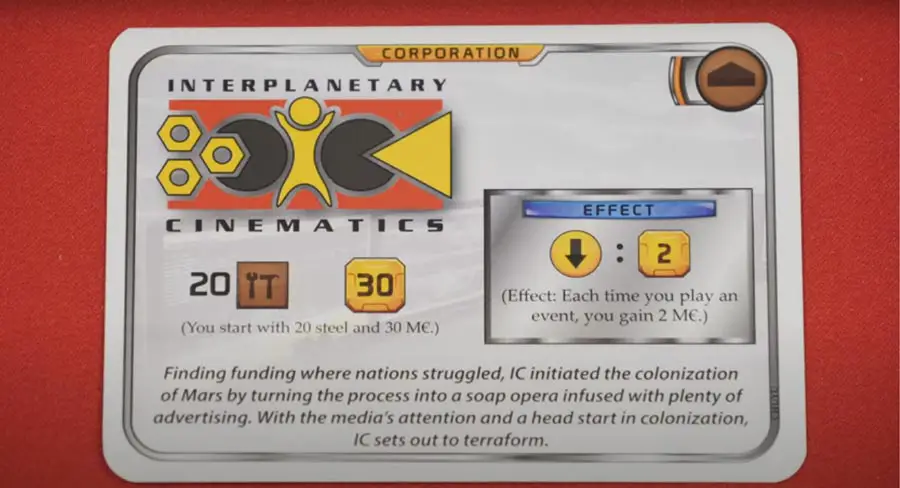
Production Phase
Quando todos tiverem concluído uma ação, pode passar-se à fase de produção.
Esta fase começa com a transferência de quaisquer recursos do cubo de Energia que possua diretamente para a área de recursos de Calor no seu tabuleiro de jogador. Após este passo, ganha recursos com base nos seus níveis de produção actuais.
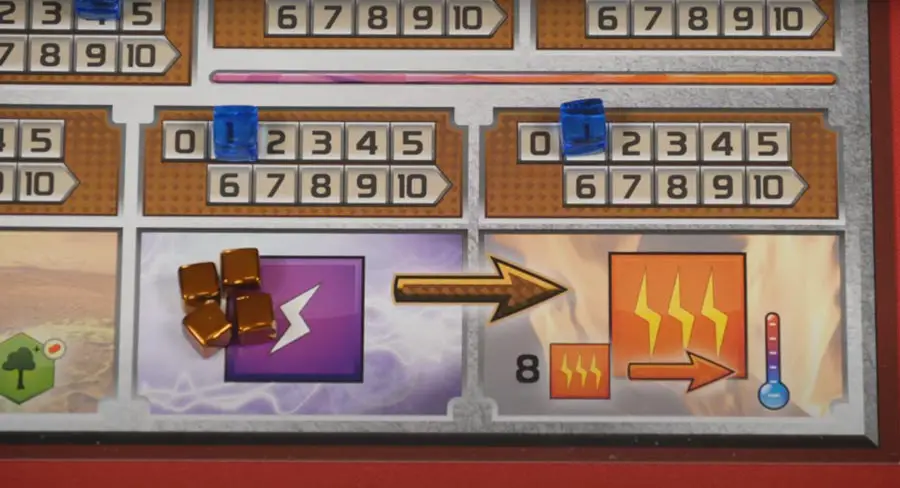
Por exemplo, se tiveres uma TR de 22 e um valor de produção de 2 na tua pista de Megacréditos, recebes um total de 24 Megacréditos.
Os restantes recursos que ganha baseiam-se no seu valor de produção individual.
Neste exemplo, obtém 8 de aço, 8 de titânio, 7 de plantas, 3 de energia e 4 de calor.
Por fim, retire todos os marcadores de jogador das suas cartas usadas para mostrar que podem ser utilizadas novamente.
Agora, está pronto para começar uma nova geração!
Player Order Phase
Ao contrário da primeira geração, as gerações seguintes terão uma "Fase de Oder do Jogador", em que a ficha do primeiro jogador é passada no sentido dos ponteiros do relógio e o marcador de geração avança uma casa no tabuleiro. Isto não afecta necessariamente o jogo normal, mas terá uma função significativa nas versões Variante e Solo de Terraforming Mars.
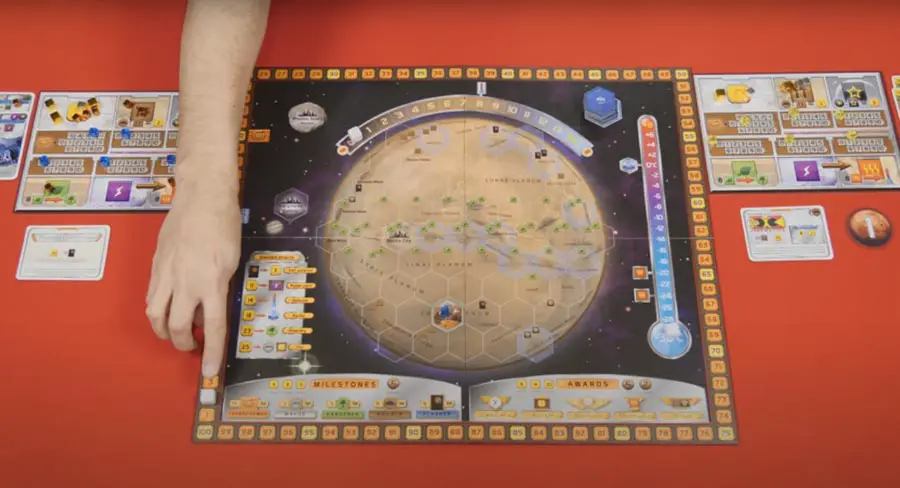
Research Phase
Durante a fase de pesquisa, cada jogador compra quatro cartas e escolhe as que quer manter, pagando 3 Megacréditos ao Abastecimento. As cartas que não escolher, coloca-as viradas para baixo na pilha de descarte, à semelhança do que fizemos durante a Preparação.
Não há limite de mão no jogo e se alguma vez ficares sem cartas da pilha de compra, basta baralhar novamente as cartas da tua pilha de descarte e distribuí-las em conformidade.
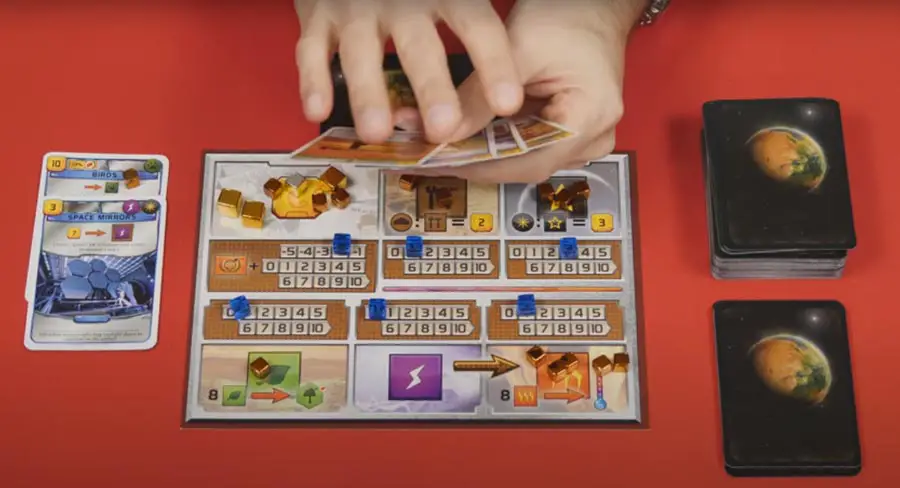
Agora, é de novo tempo para a Fase de Ação, que continuará como explicado anteriormente na primeira parte deste guia.
O jogo continua até que os três parâmetros atinjam os seus níveis máximos, após o que a ronda termina com a fase de produção.
Mencionámos anteriormente que os jogadores têm uma última oportunidade de tornar o planeta um pouco mais verde, por isso, depois de completarem a Fase de Produção, os jogadores podem converter quaisquer 8 plantas numa nova Peça Verde para adicionar ao tabuleiro.
Final Scoring
Considera o teu Terraforming Rating (TR) como a tua pontuação de base, à qual acrescentas os teus Prémios (5 pontos para o 1º lugar e 2 pontos para o 2º lugar) e os teus Marcos (5 pontos para o 1º lugar e 2 pontos para o 2º lugar).
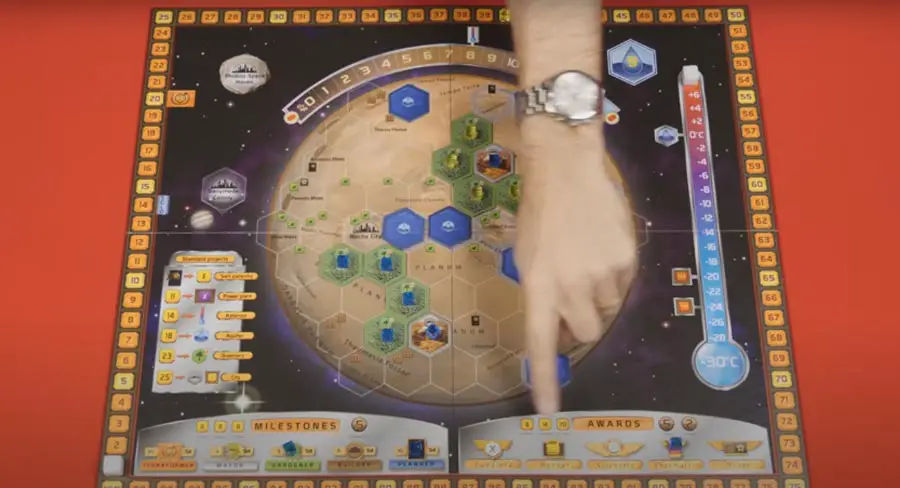
Mais uma vez, se 2 jogadores empatarem no 2º lugar, cada jogador recebe 2 pontos, mas se 2 jogadores empatarem no 1º lugar, ambos recebem 5 pontos e nenhum outro jogador será nomeado para o 2º lugar.
Recebe 1 ponto por cada peça de verde que tenha no lugar. Por cada peça de cidade que possua, a pontuação é atribuída a cada peça de verde adjacente a ela (1 por cada).
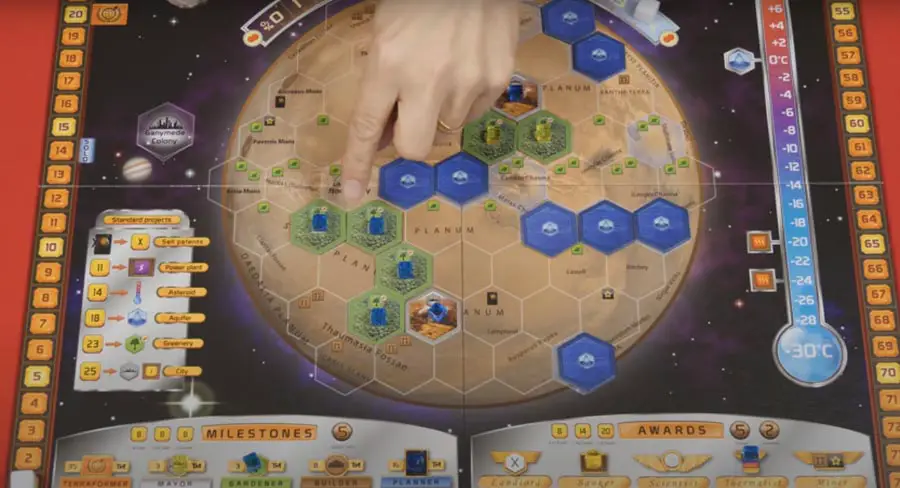
Finalmente, conta todos os teus pontos de Vitória das tuas cartas viradas para cima e vira todas as cartas viradas para baixo para ganhares também os pontos delas.
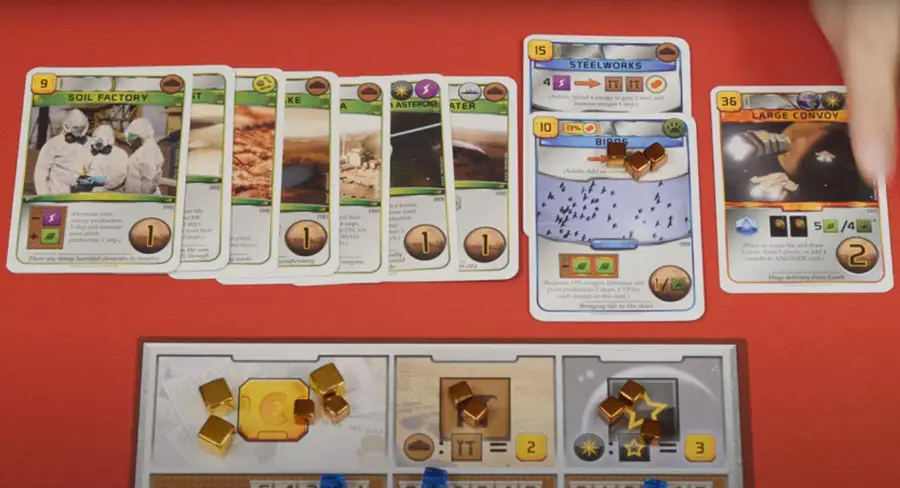
Nesta fase, o jogador com mais pontos é o vencedor, mas em caso de empate, ganha o jogador com mais Megacréditos.
Terraforming Mars Variants
Terraforming Mars tem duas variantes que iremos analisar brevemente nesta secção: a variante Solo e a Era Empresarial.
Solo Variant
Ao jogar a variante Solo de Terraforming Mars, o seu objetivo é terraformar Marte antes de passarem 14 gerações.
Para começar a jogar, adiciona as cartas da Era Corporativa ao teu baralho. Tira 2 Cartas de Corporação e 10 Cartas de Projeto e guarda aquelas com que queres jogar. Tal como no jogo normal, cada carta de projeto que escolheres manter na tua mão custará 3 Megacréditos. Agora, coloca um marcador de jogador no TR "14" que será marcado como "Solo" no teu tabuleiro de jogo. Depois coloca um dos marcadores de geração no TR "1".

Em seguida, adiciona 2 peças neutras de cidade e 2 peças de vegetação ao tabuleiro de jogo. Para isso, tira uma carta do baralho e utiliza o número no canto superior esquerdo da carta como base para colocar a sua peça. Para facilitar e como referência, vê este vídeo.
Quando tudo isto estiver definido, podes começar a jogar como no jogo normal, até atingires o máximo dos 3 Parâmetros Globais.
Corporate Era Variant
A variante Era Corporativa é uma versão alargada de Terraforming Mars, o que significa que demora mais tempo a ser concluída. Isto adiciona todas as cartas corporativas que normalmente descartarias durante um jogo base e também significa que começas o jogo com valores de produção ZERO para TODOS os teus recursos. Esta é uma variante mais complicada do jogo, e é por isso que não a recomendamos para principiantes.
Quando escolheres as tuas quatro cartas corporativas, pega numa e passa as restantes três para o jogador seguinte à tua esquerda. Continua a fazer isto até que todos os jogadores tenham quatro cartas nas mãos e descarta as que não queres usar como padrão. Isto acrescenta mais interação entre os jogadores no jogo, pois pode ajudar-te a impedir que os teus adversários ponham as mãos em grandes cartas. A única desvantagem é que também vai atrasar um pouco as coisas.
Conclusão
Terraforming Mars é um excelente jogo para jogar com os amigos e a família. Incentiva o planeamento estratégico e desafia o jogador de várias formas, incluindo a gestão do orçamento e dos recursos. É ótimo para qualquer fanático de Marte, amante da ciência, que queira ter uma experiência em primeira mão na terraformação do planeta Marte.
Esperamos que este guia sobre como jogar Terraforming Mars o tenha ajudado a compreender um pouco melhor o jogo.
Divirta-se a explorar!
